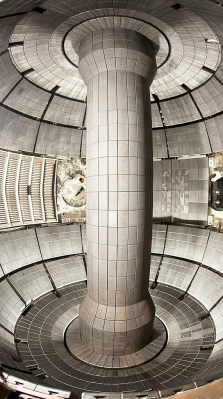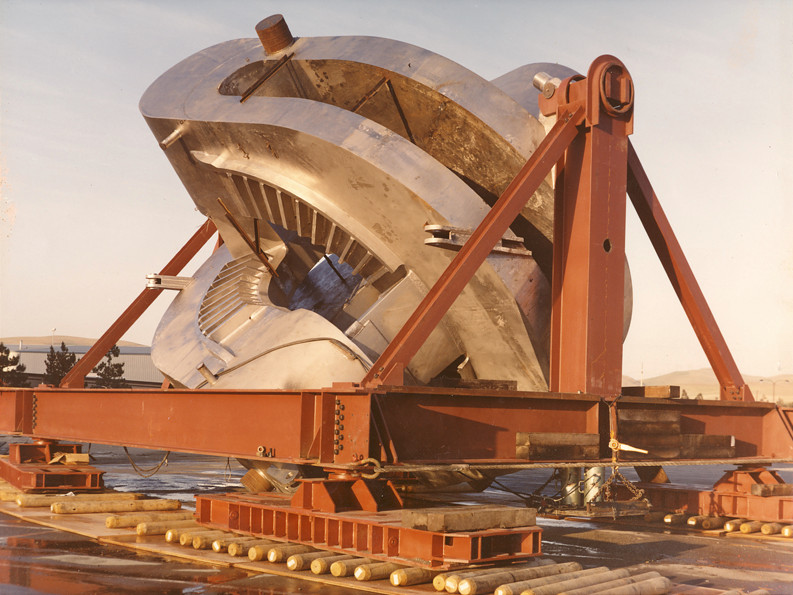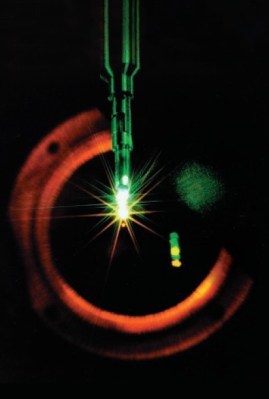When it comes to nuclear fusion, the most well-known reactor type today is no doubt the tokamak, due to its relatively straight-forward concept of plasma containment. That’s not to say that there aren’t other ways to accomplish nuclear fusion in a way that could conceivably be used in a commercial power plant in the near future.
As we covered previously, another fairly well-known type of fusion reactor is the stellarator, which much like the tokamak, has been around since the 1950s. There are other reactor types from that era, like the Z-pinch, but they seem to have all fallen into obscurity. That is not to say that research on Z-pinch reactors has ceased, or that other reactor concepts — some involving massive lasers — haven’t been investigated or even built since then.
In this article we’ll take a look at a range of nuclear fusion reactor types that definitely deserve a bit more time in the limelight.
Inertial Confinement Fusion

Inertial Confinement Fusion (ICF) relies on the rapid transfer of energy into a fuel target — usually a fuel pellet. This causes the outer layer of the pellet to rapidly expand, causing a shock wave to travel inwards, into the target. If done properly, this causes compression of the fuel (usually deuterium and tritium) at sufficient levels to start a fusion reaction that travels outwards from the center.
The use of ICF ranges from fusion weapons research to generating electricity. France’s Laser Mégajoule (LMJ) is an example of the former, whereas the US’s National Ignition Facility (NIF) is the world’s most prominent example of the latter, though it has also been used for materials science and weapons research.
Both LMJ and NIF use lasers to transfer energy to the fuel pellets, which in the case of NIF involves 192 main laser amplifier beamlines that amplify the initial low-power (1 billionth of a joule) laser pulse to the target of about 4 million joules, with each beam traveling 1.5 km before hitting the target.
At this point in time, there are a number of ICF facilities operating around the world, though some newer ones like the EU’s HiPER ICF project never got off the ground. Interest in ICF seems to be waning on account of its economic viability as an energy source remaining questionable. This is mostly due to the cost of the fuel pellets and surrounding infrastructure. Unless ways can be found to sharply reduce these costs, it seems unlikely that ICF reactors will be used for anything other than materials science and weapons research.
Magnetic Confinement Fusion
Although tokamaks and stellarators are also Magnetic Confinement Fusion (MCF) reactor designs, they are not the only type of MCF reactor. The Z-pinch reactor design is another type of MCF reactor, using the Lorentz forces through the plasma instead of surrounding the plasma with (super-conducting) magnets. The main advantage of the latter approach is that it allows for continuous operation, something which is a fairly unique property in fusion reactor designs, which most commonly use a pulse-based design.
Whereas ITER is considered to be a bog-standard tokamak design, along with China’s HL-2M and upcoming CFETR tokamaks, more exotic configurations are also being worked on. One of the most prominent being the ARC design. The acronym stands for ‘Affordable, robust, compact’, one can tell where its focus lies. While ITER and CFETR are massive tokamaks with a large internal volume, ARC aims to use ReBCO — rare-earth barium copper oxide — high-temperature superconducting magnets.

Theoretically, this should allow ARC to generate a stronger magnetic field than current tokamaks, doubling the magnetic force on the plasma, while allowing it to be much more compact and sheeting the requirement the same level of cryogenics as low-temperature superconducting magnets. It is also suggested that the use of ReBCO would allow for enough flexibility to allow the tokamak to be ‘folded open’ when not in use, to allow for easy maintenance. At this point, however, ARC is a purely theoretical design by MIT and PSFC. It’s possible that a demonstration reactor (SPARC) could be constructed in the future.
Spherical tokamaks (STs) are another interesting topic of current research. The principle here is simple: instead of forcing the plasma into a tokamak’s typical toroidal (‘doughnut’) shape, it is allowed to take on a spherical shape as much as possible, with only a minimal ‘hole’ in the center for the central magnets. This should make a reactor less expensive and easier to manage. A currently active ST is the National Spherical Torus Experiment, (NSTX) constructed by Princeton Plasma Physics Laboratory along with Oak Ridge National Laboratory, Columbia University and University of Washington.
After an upgrade between 2012 and 2015, NSTX was renamed to ‘NSTX-U’, for ‘Upgrade’. This version was stopped in 2016 due to issues with its poloidal coils, which required dismantling of a significant part of the reactor to diagnose and fix the issue. Reactivation of NSTX-U is not planned until the end of 2020. With some luck we’ll be seeing more of this reactor soon.
An interesting proposition by some scientists involved in STs is to replace the central magnet column with a design inspired by the Z-pinch reactor, using Lorentz forces to provide the magnetic field in the center instead of a physical column. This would allow for an ST to form a virtually perfect sphere of plasma.

Finally, Lockheed Martin’s Compact Fusion Reactor (CFR) has received a lot of attention since they announced it in 2014, conveniently omitting that a lot of work was still left to be done on the design. This MCF design is interesting because it appears to revive the concept of a magnetic mirror, a fusion design that many had thought to have been left behind in history after the Mirror Fusion Test Facility was shut down in the 1980s. Time will tell whether the demise of magnetic mirror reactors was truly exaggerated.
Worthy of mention is the Field-Reversed Configuration (FRC). Although not as prominently present in power generation research, FRC has the interesting property that by trapping plasma on closed magnetic field lines, it can manipulate this plasma to be accelerated in one direction, which would make it useful for spacecraft propulsion. It’s one of various possible new propulsion designs under consideration.
Here’s to All the Other Designs

Although the goal of this article wasn’t to provide an exhaustive list of current fusion power reactors, it should at least give a solid overview of the big players on the field at this point in time. There are countless smaller players out there as well, often start-ups testing out a new idea or concept using some funding money. Some of those designs may prove to work well as a neutron source, while an occasional concept may make it past the prototyping stage and show enough promise to be considered for something more.
The most exciting thing about nuclear fusion research is perhaps that nothing is set in stone. Much like the plasma inside a tokamak, it constantly changes shape and direction. Once it was thought that the stabilized Z-pinch reactor design was going to work, only for that to fall apart. Then there are the magnetic mirror, stellarator, tokamak (spherical or toroidal), and ICF configurations. Nobody can tell which of these approaches will turn out to be the golden ticket towards the one design that will end up getting commercialized.
This knowledge, along with the promise of the immense pay-off if one cracks this one, has led to a modern day gold rush. Who will figure out the first commercial scale fusion power reactor? The first compact and cheap fusion reactor? The first fusion battery that will run a smartphone for a decade? The first fusion powered spaceship?
With the tokamak design seemingly reaching its zenith with ITER and CFETR, we might end up with another ZETA moment in another decade or two with plasma physics throwing an unexpected spanner in the wheels, or we will have 2 GW commercial fusion reactors churning out cheap, clean power by the 2030s. Nobody knows for sure. That’s both exciting and terrifying, which is exactly the kind of situation that draws in those who are in for a bit of adventure.
Here’s to keeping that bright star of fusion research burning.
[Featured image: The preamplifiers of the National Ignition Facility in 2012. (CC-BY 3.0, Damien Jemison/LLNL)]
No comments:
Post a Comment